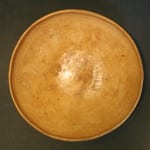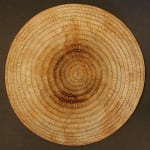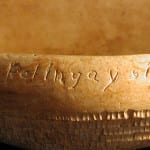“Polingaysi,” the Hopi word for butterfly, is etched into the smooth rim of this pot—which was a fact not noticed by the auction house that sold it. The basket into which the clay was pressed had 16 coils; the bottom few coils of clay on the outside of the pot appear to have been burned in the firing. The clay, especially on the smooth rim, appears to be mottled, as if Polingaysi had incompletely mixed together two types of clay before she formed the pot. A similar pot in the collection of the Museum of Northern Arizona was made in 1979 (Allen, 1984:80 #E8422).
Sotheby’s reported (12/4/97) that “In searching for a style and technique (Elizabeth White) found a uniquely colored clay, which when combined with her elegant and simple forms, contrasting color and texture became her hallmark” (Cited in Schaaf, 1998:163). This “unique” clay may provide the mottled look.
The auction house that sold this pot described it as “utility ware” because of its unpainted surface and basket impression. A comparison of this pot with a true basket-impressed utility pot (see 2005-01) indicates that 2005-08 is much thinner, delicate, and not meant for use. Polingaysi’s pot is so thin that the basket-impressed ridges can be seen and felt from the inside. The extreme thinness between the ridges and the burnt bottom suggest that it was not only formed in a basket, but also perhaps fired in the basket, which burnt off.
Active as a potter from 1954 to about 1981, Polingaysi worked in the Third Mesa village of Kykotsmovi (New Orabi). She was born in Old Oraibi in 1892 and died in Phoenix in December of 1990. Unlike almost all other Hopi potters, Elizabeth White did not learn her pottery making as a young girl or from female relatives. Schaaf (1998:163) claims that Ms. White was taught potting by Charles Loloma (a famous jeweler, ceramicist and very modern iconoclastic Hopi artist) “who taught classes at Flagstaff and Sedona, after he came back from Alfred University.” Richard Spivey writes, “There were some early innovators at the Santa Fe Indian school such as Charles and Otalie Loloma, who used non-Indian materials and techniques in stoneware production; but Qoyawayma was among the first to create new forms using native materials and inspiration (1995:91).” According to Lydia Wyckoff (1985:122) it was not until Ms. White retired from a quarter century of teaching in 1954 that she began to learn pottery making. She was 62 years old and made pottery until the early 1980s when she entered a retirement home in Flagstaff.
If this pot is about the same age as the similar pot in the MNA collection, it was made during the last few years of Polingaysi’s pottery production. The MNA has at least 10 Elizabeth White ceramics in its collection (Allen,1984). Lydia Wyckoff writes that when Ms. White began to learn about clay in 1954, her requests for assistance from First Mesa potters was rejected and similar requests to the few Third Mesa potters would probably have also been rejected. She “had little choice, then, but to be helped by her Anglo friends…Her association with these friends, and the close contact maintained by her residence in Flagstaff, have provided her with sale outlets, first through art galleries or the Museum of Northern Arizona…. (Now with her failing health and small production) most of her sales have been directly to collectors (1985:122).” Because she was recognized by the Anglo “fine art” market at a time when most Native American art was seen as just “craft,” Elizabeth White’s pots have always been expensive relative to the work of other Hopi potters. (See Wyckoff, 1985:122; and Schaaf, 1998:163.)
Wyckoff’s description of Ms. White’s aesthetic sensibility perhaps best describes the somewhat contradictory pressures of Anglo concepts of “art” and Hopi tradition on Polingaysi’s work:
“Both Faith (another Third Mesa potter) and Elizabeth White are Progressives and devout Christians who reside in New Orabi, although Elizabeth White spends the winter in Flagstaff. Of all the potters on Third Mesa these two potters have the most Americanized idea of what their pottery means. They both regard their pottery as works of art, the product of their own inspiration. They both developed their own unique style (perhaps) because they had to produce ceramics that appealed to Anglo-Americans…. Elizabeth White is clearly an individualist and works alone. (1985:121)”
These aesthetic evaluations seem present in 2005-08. Though clearly inspired by traditional Hopi basket-impressed utility ware like 2005-01, Polingaysi’s pot is not about utility—it is art: a simple, elegant, delicate form with almost a Zen-like serenity. This quality is so strong that I sensed it from a small auction house photograph and bid on the pot. Formed using a 1000-year-old technique, this pot—like Polingaysi Qoyawayma/Elizabeth White herself—is a mixture of Hopi tradition and non-Hopi aesthetic sensibility.
Polingaysi taught her nephew Al Qoyawayma to make pottery in the early 1960s. “Al Q,” like his aunt, stands in both the Western and Hopi worlds (he was raised in Los Angeles and is a mechanical engineer). Also like his aunt, Al Q’s pottery (see 2006-03) is inspired by Hopi life but is modern in form.
The other basket-impressed pots in the collection are true utility pots. Each is from Third Mesa, generally the village of Hotevilla. (For other basket-impressed pots in the collection, see “Utility Pots” in the Category List.)





